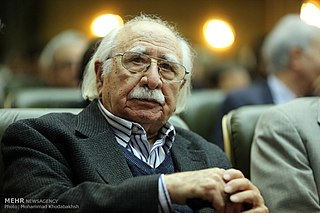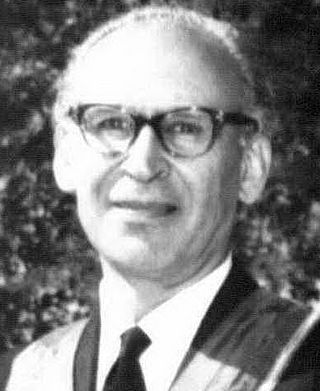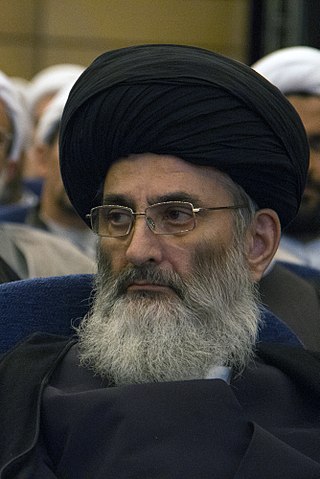Abdolmohammad Ayati was an Iranian author, translator and researcher in the field of philosophy, history and Persian and Arabic literature. He was born on 5 May 1926 in Borujerd, Borujerd County, Lorestan Province, Iran and died on 11 September 2013 in Tehran, Iran. He was selected at the second Iran's Book of the Year Awards for Arabic to Persian translation of the book History of Arabic Language Literature.
Mohammad Ali Ibn Mohammad Taher Ibn Nader Ibn Mohammad Taher Tabrizi or Mohammad Ali Modarres Khiabani or Mohammad Ali Modarres Tabrizi was an Iranian author, mojtahed and scholar. He was born in 1878 in Tabriz, East Azerbaijan Province, Iran and died on 5 April 1954 in Tabriz, East Azerbaijan Province, Iran and buried in Sheikhan cemetery, Qom, Iran.

Sheikhan cemetery is the second historical cemetery in the Islamic world and one of the oldest cemeteries in Qom, Qom Province, Iran which is located near the Fatima Masumeh Shrine. The cemetery dates back over a thousand years.

The Iranology Foundation is a scientific and research institute in Iran and Iranian studies is the main field of its activities. The Foundation's studies and researches are all topics and issues related to various manifestations of Iranian culture and civilization. The institute was established in 1997 under the supervision of the Presidential Administration of Iran.
The Comprehensive History of Iran is a twenty-volume book series about various aspects of Iran's political, social and cultural history from pre-Islamic times to the extinction of the Qajar dynasty. The research, compilation and writing of this multi-volume book has lasted for 14 years. The first five volumes of this series narrate the period of ancient Iran and the other 15 volumes narrate the history of Iran in the Islamic period, political, social, cultural, scientific, literary and artistic history. One hundred and seventy foreign and domestic authors have been used to write this multi-volume book.
Alireza Feyz was an Iranian author, researcher of Islamic jurisprudence and Islamic philosophy, professor at the University of Tehran and jurist.

Fathollah Mojtabaei is an Iranian author and historian. He is a permanent member of Academy of Persian Language and Literature and a member of the faculty of the Center for the Great Islamic Encyclopedia.

Rasul Jafarian is an Iranian clergyman and researcher in field of Iranian history. He is currently the Professor of the Department of History at the University of Tehran, the Director of The specialized library on Islam and Iran, and the Director of the Central Library of the University of Tehran. Rasul Jafarian became a permanent member of the Academy of Sciences of Iran in June 2018 with the vote of the members of the General Assembly of the Academy of Sciences.

Bibliography of Rasul Jafarian is a list of books published by Rasul Jafarian, cleric, translator, writer and researcher of Iranian history.
History of Islamic Iran is a four-volume book collection written by Rasul Jafarian in Persian language. In this collection, Jafarian writes the history of Iran from the advent of Islam to the decline of the Safavid Empire. This book has been introduced as one of the master's degree resources in the field of history and Persian literature in Iran.
The Political History of Islam is the name of a two-volume book written by Rasul Jafarian, the first volume of which is entitled "The life conduct of the Prophet " in 692 pages and the second volume is entitled "History of the Caliphs" in 828 pages. The book has been translated into English, Arabic and Urdu.
The intellectual and political life of Shia Imams is the name of a book by Rasul Jafarian that has been written with the aim of investigating the political and intellectual aspects of the life of the Shiite twelve Imams. The content of this book was first published as a series of articles in Noor-e Elm magazine and then became an independent book. The book has also been translated into Arabic and Urdu. In 2011, the book was published again with many corrections. Excerpt and summary of this book in 400 pages has been selected by the Research deputy of Islamic Maaref University as a textbook in universities of Iran for history of Imamate course.

Mehdi Bayani was the founder and the first head of the National Library of Iran, specialist in Persian manuscripts and calligraphy, writer, researcher, and professor at the University of Tehran.

This is a bibliography of the works of Morteza Motahhari.

Mullah Mohammad Jafar Sabzevari was one of the Iranian scholars and clerics of the 12th century AH, the Imam of Friday Prayer of the Shah Mosque in Isfahan and the author of several books and treatises including "Nowruznameh" and "Ma'ad" which was compiled at the request of Shah Sultan Hussein Safavid.

Mahmoud Mar'ashi Najafi or Seyyed Mahmoud Mar'ashi Najafi is an Iranian librarian, Bibliographer and manuscript expert. He is the director of Mar'ashi Najafi Library, which he says is one of the largest libraries in Iran and the world.

Seyed Reza Bahaadini was an Iranian Shia jurist, teacher of ethics and practical mysticism. He was one of the disciples of Abdul-Karim Haeri Yazdi, Seyyed Mohammad Hojjat Kooh Kamari, Seyyed Mohammad Taghi Khansari and Hossein Borujerdi. His greatest occupation and fame was his public or private debates on Islamic ethics courses, which lasted until the last days of his life.

Insha-Allah Rahmati is an Iranian philosopher, thinker, translator and a full professor of philosophy at Islamic Azad University in Tehran. His main interests are Ethics, Islamic philosophy and Traditionalist School (perennialism).

Zahabiya Sufism is a Shiite order. The history of dervishes from this order dates to the third century AH and Ma'ruf al-Karkhi. Some believe that the order originated during the ninth century AH in Iran; it first became popular in Khorasan and then in Shiraz during the early Safavid period.

Islamic Philosophy from its Origin to the Present: Philosophy in the Land of Prophecy is a book by Seyyed Hossein Nasr, Iranian philosopher and University Professor of Islamic studies at George Washington University. The book is a history and overview of Islamic philosophy covering its origins in the 9th century to the modern era.












